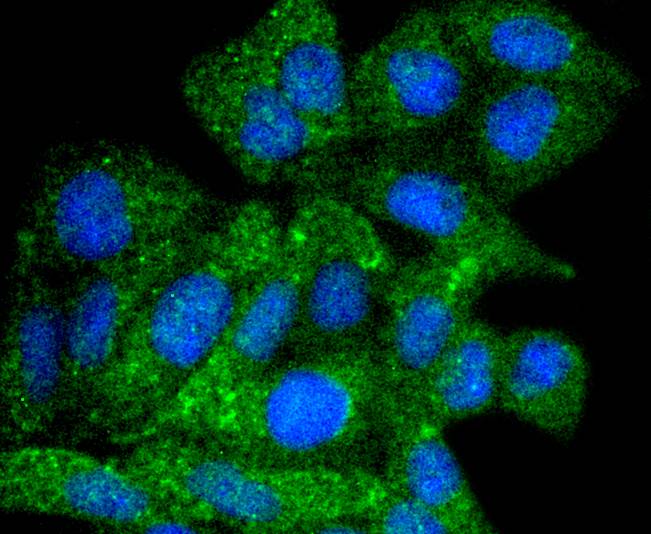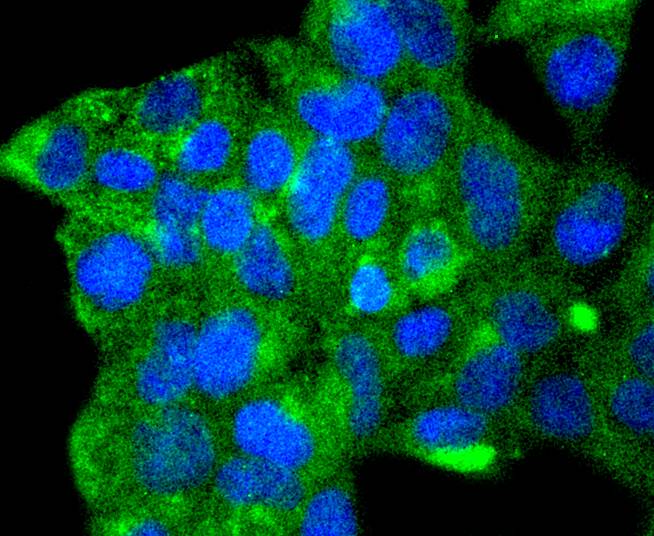Product Name :
ATG9A polyclonal antibody Background :
Autophagy, a process that results in the lysosomal-dependent degradation of cytosolic compartments, is carried out by the autophagosome, which is a double-membrane vesicle whose formation is catalyzed by several autophagy-related gene (Atg) proteins. Atg9a (autophagy-related protein 9A), also known as APG9-like 1, is a 839 amino acid, multi-pass membrane protein that localizes to the pre-autophagosomal structure (PAS). Isolation membranes are suggested to originate from the PAS, enwrapping cytoplasmic components to form a double membrane autophagosome, which then fuses with the vacuole. Ubiquitously expressed in human adult tissues, Atg9a cycles between the Golgi and endosomes and, with the autophagosome-specific marker LC3, plays a critical role in starvation-induced autophagosome formation. Three isoforms of Atg9a exist as a result of alternative splicing events. Product :
Rabbit IgG, 1mg/ml in PBS with 0.02% sodium azide, 50% glycerol, pH7.2 Storage&Stability :
Store at +4°C after thawing. Aliquot store at -20°C or -80°C. Avoid repeated freeze / thaw cycles. Specificity :
ATG9A polyclonal antibody detects endogenous levels of ATG9A protein. Immunogen :
recombinant protein Conjugate :
Unconjugated Modification :
Unmodification
ATG9A polyclonal antibody Background :
Autophagy, a process that results in the lysosomal-dependent degradation of cytosolic compartments, is carried out by the autophagosome, which is a double-membrane vesicle whose formation is catalyzed by several autophagy-related gene (Atg) proteins. Atg9a (autophagy-related protein 9A), also known as APG9-like 1, is a 839 amino acid, multi-pass membrane protein that localizes to the pre-autophagosomal structure (PAS). Isolation membranes are suggested to originate from the PAS, enwrapping cytoplasmic components to form a double membrane autophagosome, which then fuses with the vacuole. Ubiquitously expressed in human adult tissues, Atg9a cycles between the Golgi and endosomes and, with the autophagosome-specific marker LC3, plays a critical role in starvation-induced autophagosome formation. Three isoforms of Atg9a exist as a result of alternative splicing events. Product :
Rabbit IgG, 1mg/ml in PBS with 0.02% sodium azide, 50% glycerol, pH7.2 Storage&Stability :
Store at +4°C after thawing. Aliquot store at -20°C or -80°C. Avoid repeated freeze / thaw cycles. Specificity :
ATG9A polyclonal antibody detects endogenous levels of ATG9A protein. Immunogen :
recombinant protein Conjugate :
Unconjugated Modification :
Unmodification
-
 ICC staining ATG9A in Hela cells (green). The nuclear counter stain is DAPI (blue). Cells were fixed in paraformaldehyde, permeabilised with 0.25% Triton X100/PBS.
ICC staining ATG9A in Hela cells (green). The nuclear counter stain is DAPI (blue). Cells were fixed in paraformaldehyde, permeabilised with 0.25% Triton X100/PBS. -
 ICC staining ATG9A in 293 cells (green). The nuclear counter stain is DAPI (blue). Cells were fixed in paraformaldehyde, permeabilised with 0.25% Triton X100/PBS.
ICC staining ATG9A in 293 cells (green). The nuclear counter stain is DAPI (blue). Cells were fixed in paraformaldehyde, permeabilised with 0.25% Triton X100/PBS.
Bioworld Biotech only provide peptides for our antibodies and do not provide additional peptide customization services.
Price/Size :
USD 368/1mg/vial
Tips:
For phospho antibody, we provide phospho peptide(0.5mg) and non-phospho peptide(0.5mg).Describe :
Blocking peptides are peptides that bind specifically to the target antibody and block antibody binding. These peptide usually contains the epitope recognized by the antibody. Antibodies bound to the blocking peptide no longer bind to the epitope on the target protein. This mechanism is useful when non-specific binding is an issue, for example, in Western blotting (WB) and Immunohistochemistry (IHC). By comparing the staining from the blocked antibody versus the antibody alone, one can see which staining is specific; Specific binding will be absent from the western blot or IHC performed with the neutralized antibody.Formula:
Synthetic peptide was lyophilized with 100% acetonitrile and is supplied as a powder. Reconstitute with 0.1 ml DI water for a final concentration of 10 mg/ml.The purity is >90%,tested by HPLC and MS.
Storage:
The freeze-dried powder is more stable. For short time at 2-8°C. For long term storage store at -20°C.
Note :
This product is for research use only (RUO only). Not for use in diagnostic or therapeutic procedures.
 ATG9A polyclonal antibody
ATG9A polyclonal antibody  Datasheet
Datasheet COA
COA MSDS
MSDS SHIP
SHIP